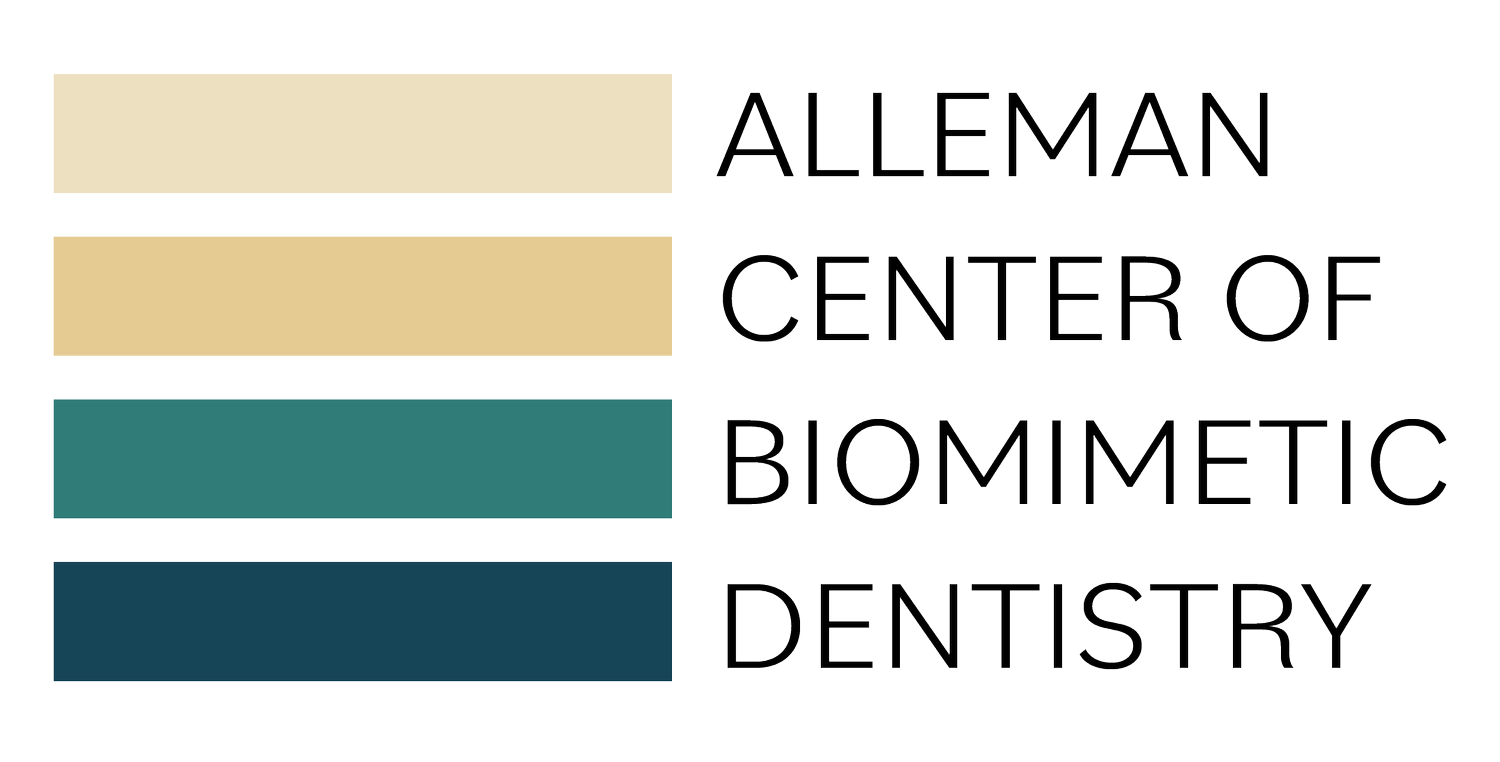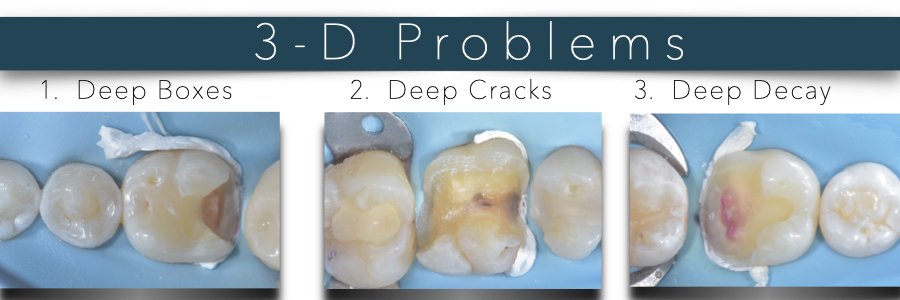Understanding & Treating Deep Cavities
“The life of a dentist is not incipient lesions.” - Dr. David Alleman, DDS
For practitioners around the world, daily dentistry is more complicated than incipient lesions. Doctors are confronted with deep boxes, deep decay and deep cracks, what we at the Alleman Center call “The Three D Problems.” These deep cavities bring bacteria close to the pulp, putting it at risk of infection and death, while often resulting in pain or sensitivity for patients. Understanding the challenges and researched restorative techniques for tackling these deep areas is essential for a long-lasting, asymptomatic restoration.
Being able to predictably treat difficult cases like these by Dr. Davey Alleman, DMD conserves tooth structure and preserves tooth vitality.
What causes deep cavities?
Deep cavities can result from untreated pathologies or previous restorative work.
If decay (caries) is not caught early, the bacteria can degrade the collagen in dentin, creating decayed tissue that results in a cavity that will grow in size. Bi-annual dental cleanings with exams and x-rays help catch caries early to stop the lesions from growing larger.
Deep caries is shown by caries detector dye in this case by Dr. Davey Alleman, DMD. Despite the deep cavity, this tooth tested vital and was restored using biomimetic restorative dentistry. Now this tooth’s pulp has the chance to heal.
If caries or cracks have been found in a tooth and treated, the portions of the tooth affected by the pathology will have been removed. If previous restorative treatment fails, often that cavity will need to be re-treated and the size of the cavity increased. Biomimetic dentistry stops this restorative cycle of increasingly invasive treatment by sealing the dentin to stop re-decay and bonding the tooth to keep it sealed and functional for decades.
Initial photo for a tooth previously restored using traditional techniques.
The old amalgam is removed, showing decay and cracks underneath.
The previous restoration failed to support the tooth’s structure and seal it against bacteria. The resulting decay and cracks from the open margin meant that when the tooth is retreated, additional tooth structure must be removed. Biomimetic restorations stop this cycle by creating a seal that stays bonded.
Case by Dr. Davey Alleman, DMD
Deep cavities pose difficulties with treatment
When teeth are treated at your office for deep caries or have been previously treated and require retreatment, working in deep cavities puts the tooth at risk:
When deep dentin is exposed by a cavity, pioneer bacteria from the caries have likely already entered the pulp. This may cause pain or sensitivity for patients as the pulp fights the infection.
If the tooth is being retreated after an amalgam restoration or poorly sealed composite restoration, the remaining tooth structure around the restoration is weakened from the previous preparation. Natural teeth are supported by webs of enamel across the occlusal surface. When those occlusal surfaces are removed, the tooth will bend and flex more than it is naturally designed to do, resulting in cracks under and around the restoration.
Treating the tooth near the pulp puts it at risk of exposure, which can increase its likelihood of necrosis.
A poorly sealed composite restoration has led to a cusp fracture and decay under the restoration.
Caries detector dye shows the deep decay in this case by Dr. Davey Alleman, DMD.
Predictable protocols for treating deep cavities
Having predictable protocols when tackling difficult restorations relieves much of your stress as a practitioner because you know your final restoration will be asymptomatic and stay bonded longer than traditional restorations. Predictability is at the center of all Alleman Center training programs. These frustrations with failing restorations or symptoms that couldn’t be explained were what made Dr. David Alleman want to quit dentistry after having practiced for 15 years. Instead, he started finding mentors and studying the published literature to see how he could gain new techniques to improve restorative outcomes.
When he began implementing these new techniques and materials in 1995, he saw improvements in his restorations. Post-operative sensitivity was eliminated, the need for endodontic treatment dramatically decreased and restorations were staying bonded for years and now decades.
This case from 2005 by Dr. David Alleman, DDS shows how caries detector dye and precise measurements are used to remove caries safely around the pulp.
Clinical tips for restoring deep defects
To restore deep cavities, Alleman Center training programs give doctors a complete set of protocols to restore a tooth start to finish. Dr. David Alleman named these protocols, the Six Lessons Approach to Biomimetic Restorative Dentistry (SLA). The SLA protocols include:
Caries removal endpoints diagram from the 2012 Alleman/Magne paper.
Using caries detector dye (CDD) to objectively remove caries. A study on CDD (Anderson M, Charbeneau G. A comparison of digital and optical criteria for detecting carious dentin. J Prosth Dent. 1985;53(5): 643-646.) found that 59% of caries was left behind when practitioners used only a tactile approach. To confidently work in deep areas, use CDD to improve the predictability of your caries treatment.
Measuring 3 mm axially and 5 mm occlusally, you can prevent pulp exposures when working in deep areas. This is the Peripheral Seal Zone concept as outlined in Alleman D., Magne P. A systematic approach to deep caries removal endpoints: The peripheral season concept in adhesive dentistry. Quintessence Int. 2012;43(3)197-208.
Understanding how c-factor impacts your bond strength when working with different substrates (deep dentin vs superficial dentin).
Preventing endodontic treatment
While some deep cavities will require endodontic treatment, biomimetic dentistry includes techniques that allow many of these teeth to heal. When Dr. David Alleman began using these advanced adhesive techniques in his own practice, he saw a dramatic drop in the need for root canal treatment compared to the traditional techniques he learned in dental school. The difference was the biomimetic bond.
This case by Dr. Davey Alleman, DMD shows a premolar that traditionally would have been referred for endodontic treatment due to the deep caries. Because the tooth is testing vital, the tooth is restored, sealing deep caries around the pulp to give the pulp a chance to heal.
A tooth is bonded to itself at a strength of 30-50 MPa. If an dentin bonding system can achieve this same bond, it is considered biomimetic because it mimics a natural tooth. With Dr. Alleman’s improved techniques, he was able to achieve a bond at the nanometer level, so small that bacteria could not enter under a restoration to reinfect the pulp. This sealed off any bacteria in the pulp, allowing teeth that were testing vital to heal.
Restoring deep cavities is difficult for any practitioner, but since they are a daily occurrence in most practices, having the tools to treat them predictably and with the best possible outcome for the tooth makes the struggle worthwhile. Dentists and patients can agree that debonded restorations and post-operative sensitivity shouldn’t be the expectation, and with biomimetic dentistry these failing restorations can be a thing of the past.
Doctors can learn predictable protocols for treating deep cavities in Alleman Center dental training programs.













